Know How, Part 2
Two weeks ago I did a mailbag column where I answered questions all beginning with the word "how." Today is the second part of the article. Less recap, more questions:
ChicagoMagicMan @maro254 How has the experience of playing Magic changed since its early years? How has the experience of designing Magic changed?
So many changes have happened in the last seventeen years that it's hard to point to just one. Probably the biggest change and one that's had huge impacts on design has been the rise of Limited. In the beginning, Magic was all about Constructed play, and thus, sets could be much looser in design. As Limited started to become more important it required design to think about many more facets especially at lower rarities. This discipline though, I believe, proved very good for the game as it gave design more focus and as my faithful readers know: restrictions breed creativity. The other big change has been that design technology keeps improving, meaning we are able to do things that would have been impossible years ago.
juzamjedi @maro254 How many future blocks are already planned out right now?
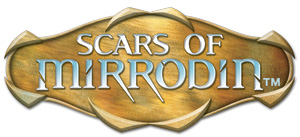 Scars of Mirrodin block is almost done. I just handed in "Shake," and I know what the rest of the block is up to. "Hook" block hasn't started yet, but I know exactly what it's doing. "Friends" block is a little more open-ended but I know who the lead designer is and I have a rough idea what he wants to do. I'm tentatively penciled in for the fall set the year after that (so far out, it's not even codenamed yet) and I have a few leading candidates of what to do. Beyond that I have a number of blocks planned that I don't know where they're going to go. Later this year, I've promised Aaron a five-year plan so I'll figure it all out soon enough.
Scars of Mirrodin block is almost done. I just handed in "Shake," and I know what the rest of the block is up to. "Hook" block hasn't started yet, but I know exactly what it's doing. "Friends" block is a little more open-ended but I know who the lead designer is and I have a rough idea what he wants to do. I'm tentatively penciled in for the fall set the year after that (so far out, it's not even codenamed yet) and I have a few leading candidates of what to do. Beyond that I have a number of blocks planned that I don't know where they're going to go. Later this year, I've promised Aaron a five-year plan so I'll figure it all out soon enough.
Ariamaki @maro254 How do you get to work at Wizards every day?
I drive about half an hour each day. I live in Issaquah, a suburb of Seattle. Occasionally, I carpool with Brian Tinsman who lives two blocks away from me. Wait, that's not what you meant, is it? You want to know how you could work here. I wish there was an easy answer but unfortunately people wanting to work in Ramp;D versus actual slots is a daunting ratio. My best advice is to keep your eyes on the Wizards job boards. If you see something you think you'd be qualified for, even if it isn't in Ramp;D, take a shot. Once you get hired at Wizards, come ask me "What do I do next?" and I'll tell you.
gfraggle99 @maro254 How do you compartmentalize in your mind all the different projects you are working on simultaneously without getting confused?
Because of all of our parallel processing, it is quite common for me to be on three design teams at once. (Such a thing will happen before July is out, for example.) In fact, there was one point several years back (during the Lorwyn/Shadowmoor block year) where I was working on three design teams each in its own block. The trick I've found is that I think of sets as a cohesive whole. That way each set has its own distinctive sense to it. When I walk into a design meeting, I often look at a few cards in the design file to remind me which set I'm in. This trick obviously works better the more clearly different the sets are from each other. As I've always made a push for each set to have its own distinctive feel, this is easier than it might be if we kept pumping out the same basic set year after year.
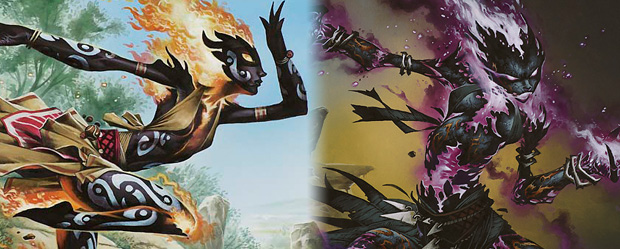
Piplodocus_ @maro254 How ... do you sleep? Joke, joke! How do you determine what needs to be a Sorcery and what can be an Instant?
How do I sleep? Like a baby: I wake myself up every three or four hours crying. Here's my rule for determining whether something should be an instant or sorcery. I ask myself, "Can it be a sorcery?" If the answer's yes, I make it a sorcery. (For more info on this, feel free to look at my columns on instants and sorceries.)
One of the reasons I love working on Magic is that the game system is so robust it easily keeps me inspired. In addition, I spend a lot of time staying attuned to the players. All of you getting excited gets me pumped up to make more Magic. Finally, Ramp;D (and Wizards) has so many people who are a joy to work with that it is easy to get inspired by your co-workers.
jsnlxndrlv @maro254 How much time must pass before you're willing to revisit a theme / setting / mechanic that had a bad reception the first time around?
How bad was the idea the first time? And was the idea what turned off players? If I believe the idea was sound but the execution was faulty I would probably wait long enough that the negative feelings of the set had a while to cool down, meaning at least five years probably more. I would then try to integrate the theme into a larger more palatable theme so that it wasn't what was carrying the brunt of the design. There is great thrill for a designer to find a way to make something work that didn't before. The classic example I'm reminded of was the card Mishra's War Machine from Antiquities. I always liked the idea of the card but felt that it wasn't presented in the best light. So I redid it as a card called Masticore. It went a little better the second time.
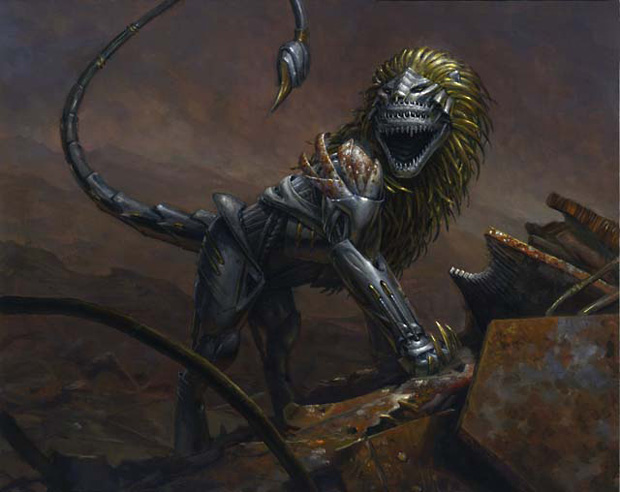
ozygo @maro254 How are cards for Eternal made? Do you sit down and say, "I will make an Eternal card." Which of these cards are used today?
The vast majority of cards that see play in Eternal formats are made like any other card. Every once in a while when designing a card we become aware of its potential use in a Vintage format and push it in a certain direction. (Examples are Mindbreak Trap and Chalice of the Void.)
jsnlxndrlv @maro254 How do you know when to abandon a particular mechanic or theme, particularly once you've invested work into its design?
The simplest answer is when playtest shows it isn't working. Design tends to go through the following cycle. 1) Come up with something design wants to explore. 2) Brainstorm the idea with the team. 3) Have the team design cards that fit what we talked about in the brainstorm. 4) Play with the cards that were designed. 5) Take in feedback and make changes on existing cards while figuring out new areas to explore. 6) Rinse and repeat.
Playtest tends to serve as a sieve that keeps in the good elements of design while letting the parts that don't work wash away. One of the most important skills in design is being able to playtest and understand what the playtest is telling you about your design. For example, I've gotten very good at learning a lot from just a single playtest. The hardest part is not knowing that the mechanic or theme is failing, it's letting it go.
little_wh0re @maro254 How do you decide a sets theme? Do you have multiple things going on which you whittle away or is it some kind of first amp; loudest?
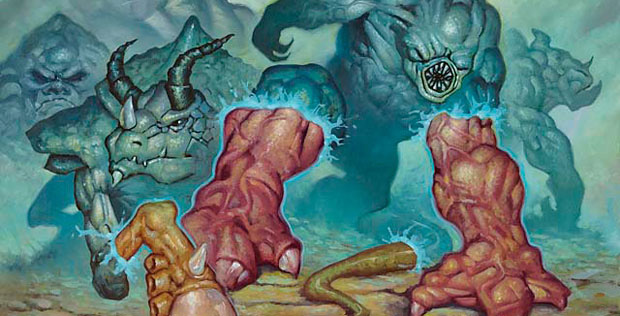
We often start our design with our theme. When we don't, whatever aspect we begin with takes shape and starts to present a theme. Time Spiral, for example, started with us trying to figure out what to do with suspend. That led to the theme of time, which in turn led to the theme of nostalgia. Zendikar, in contrast, started with a lands oriented design which led us to a creative answer for why lands were so important which led us to an adventure world theme. Each design is pretty unique so there is no one answer.
kaokun @maro254 How long have you used the current "Multiverse"? How do you wish it were better? (as a programmer, efficient tools make me happy)
Multiverse, our internal database, is constantly evolving. We're probably in the fifth or sixth iteration of it since I came to work at Wizards. Interesting trivia—the first version of Multiverse was just a Filemaker database.
RichardAyad @maro254 How do you decide what theme or keyword ideas a new set/block is going to include? Graveyard-type effects in Odyssey, for example.
Different sets start out differently. More often than not, the design team starts out with a sense of the block's theme, but not always. We've started out with a mechanic we like (Time Spiral had suspend before it had a theme). Sometimes we start out with an area of design (Zendikar went into design with "land matters"). Other times the block is about telling a certain story. Scars of Mirrodin block, for example, started out because we had an idea we felt would make a compelling block. It was an approach we had never tried before, but one we thought would make for a cool block (which it did).
rickits24 @maro254 How do you decide how to assign abilities/traits to spells of a cycle (e.g., M11 titans)? Explain blue titan w/o flying as example?
When designing a cycle you are trying to do two things. First you need continuity of the cycle. That is, the five cards have to feel connected. Next, you want each color to have its own take so that the cycle doesn't feel boring. Having five cards do the exact same thing is a waste of a cycle (usually). Why does Frost Titan, the blue titan, not have flying? Because it didn't make sense with the concept of the cycle being hulking giants. While blue has access to flying and will often use it in blue's take on a cycle, blue is about a lot more than just flying. The Frost Titan feels plenty blue without having to fly.
Twinblaze2 @maro254 How do you develop new design space within an existing mechanic?
The trick to revisiting a mechanic is twofold. First, there is a lot of positive to just doing what you did before. Every revisit does not necessarily have to add something new. Second, if you are going to try to find new design space, look at the mechanic and understand what it's about. Each mechanic has an essence that you need to maintain. The key to finding new space is to see what element of that essence has not yet been tapped. Often I will look at an old mechanic and say, "What didn't it do that it seems obvious it wants to?" The best tweaks are the ones that feel organic. I should also point out that not every mechanic necessarily has more space to explore, although most do.
Triphos @maro254 How does communication with players affect the design process beyond "players like/don't like X"?
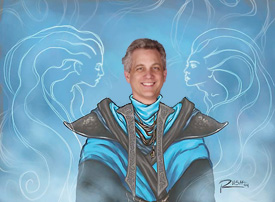 One of the most important parts of my job is to create things—be it themes, blocks, sets, cycles or cards—that connect with the players. I have to make things that all of you want to play. This means that I have to be able to gauge new mechanics and predict how popular they are going to be? I've gotten a good sense of it over the years. How? My secret weapon is this column and all the posts/mail it creates. The best way to learn what the public thinks is to ask them and then listen.
One of the most important parts of my job is to create things—be it themes, blocks, sets, cycles or cards—that connect with the players. I have to make things that all of you want to play. This means that I have to be able to gauge new mechanics and predict how popular they are going to be? I've gotten a good sense of it over the years. How? My secret weapon is this column and all the posts/mail it creates. The best way to learn what the public thinks is to ask them and then listen.
I read every email sent to me because it makes me better at my job. I know when an issue really concerns all of you, because you tell me, as well as tell each other. When a player speaks a gem of truth, I tuck it away and the next time I can use it, I do. What kind of messages are those? They're all over the board. It might be a desire for a kind of card that doesn't exist or a plea for us to stop doing something. It might be an explanation of why they like the game or a rant about how we "ruined Magic." I sometimes refer to my email as a barometer as it does a very good job of giving me a sense of how Magic is doing at any one moment. So please, keep it up. Tell me how you feel. Tell me what you would do to make Magic better or what we shouldn't get rid of. You have my ear. People would be shocked how often some line in a letter to me results in action.
honupo @maro254 How is a card selected to be in a mythic rare slot?
The two main things that tend to determine rarity are complexity and specialness. The lower the rarity, the simpler we like the card to be. Specialness though is a much more subjective quality. The way I've learned to describe mythic rares is that I like them to have a potential for awesomeness. Mythic rares want to feel like cards that can just do something crazy given the right circumstance. In addition, mythic rares want to feel like things that wouldn't be commonplace in the world where you would find them. All planeswalkers by definition are mthic rare as are the majority of legendary creatures and items. The rest is really a feel. Note that there are many cards that fall in the grey area where they could work as rares or as mythic rares and Ramp;D has to make a call on which side of the line it falls. Could a card like Vengevine be rare? Of course, it's on the line.
One final note—some people wanted to interpret my original article on mythic rares to say that there never would be powerful mythic rares. That isn't what I said. The actual quote was "They [mythic rares] will not just be a list of each set's most powerful tournament-level cards." Every rarity gets good cards. That means that some mythic rares will be tournament quality as will some commons, some uncommons and some rares. My promise wasn't that mythic rares wouldn't get good cards but that we wouldn't limit the good cards to only being mythic rare. The most played tournament card from Magic 2010, for instance, isn't Baneslayer Angel, a mythic rare, but Lightning Bolt, a common.
MikeXIV @maro254 How do you work out the color imbalance of Mythic Rares in a set or block when you want, for example, 3 colorless Mythic Rares?
Several years back, Ramp;D decided that we needn't be exact in our color balancing especially at higher rarities. This means that it's okay if some colors get more mythic rares than others.

jseakle @maro254 How do you design magic puzzles, when you do?
Keeping in theme for this column series, there are various ways to design Magic puzzles. The most common way for me is to start with what I think of as the heart of the puzzle. What's the cool thing that the puzzler has to figure out to do to solve the puzzle? Once I have my heart, I work backwards from it to build the puzzle around it. Often, I work hard to hide what I'm trying to make you do so it isn't obvious, as much of the fun of the puzzle is getting the "aha!" moment. The last part is playtesting and tweaking to prevent alternate, easier solutions and making sure the solution actually works.
davesedich @maro254 How does design decide when it's okay to allow the color pie to bleed?
During Planar
MarshallLRcast @maro254 How do you decide what % of cards are designed for what % of psychographic? E.g., Does Timmy get the most, and Vorthos the least?
Well, Vorthos and Melvin aren't included in the psychographics. (I explain it all in this article.) With that off of my chest, the answer to your question is that it's a feel thing. We don't set out early on to make Timmy cards or Johnny cards, we just make cards to fill whatever thing we're working on. Then, in the later part of design, when we're examining what's missing, that's when we start to see if some psychographic isn't having its needs met. That's when we start designing cards specifically for Timmy or Johnny or Spike.

thepchapin @maro254 How much of magic design is art vs. science? How about development?
I will only speak for design. I feel design is about 65% art and 35% science, roughly two thirds and one third. The science comes from the fact that there is a lot of math that goes into design: percentages, curves, as-fan. The art comes from the fact that a design has to have a particular feel. All the pieces have to come together to create something larger than the sum of its parts.
- "How? Scrambled."
Time to wrap up Part II. I hope you enjoyed this mailbag column and I want to thank all my tweeps (people who follow you on Twitter—I'm @maro254, if you're interested) for sending in the questions.
Join me next week, when I explain how to find your voice.
Until then, may you be able to answer many "how" questions.



